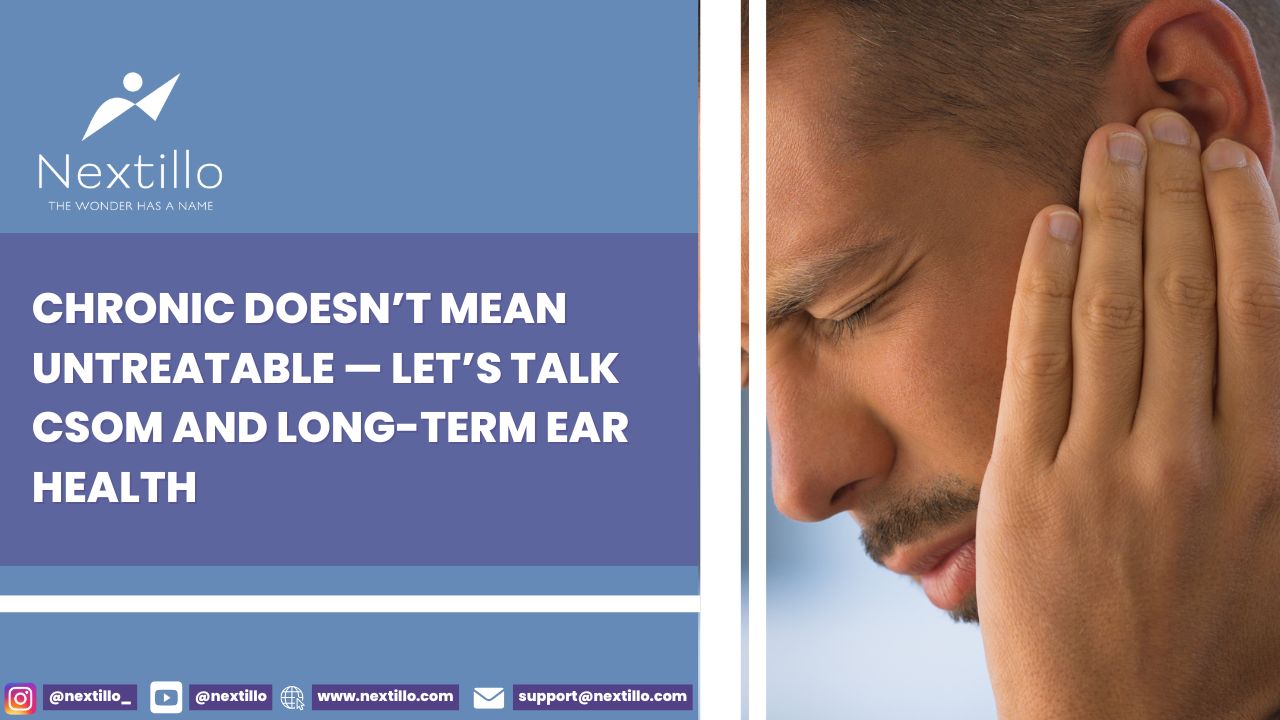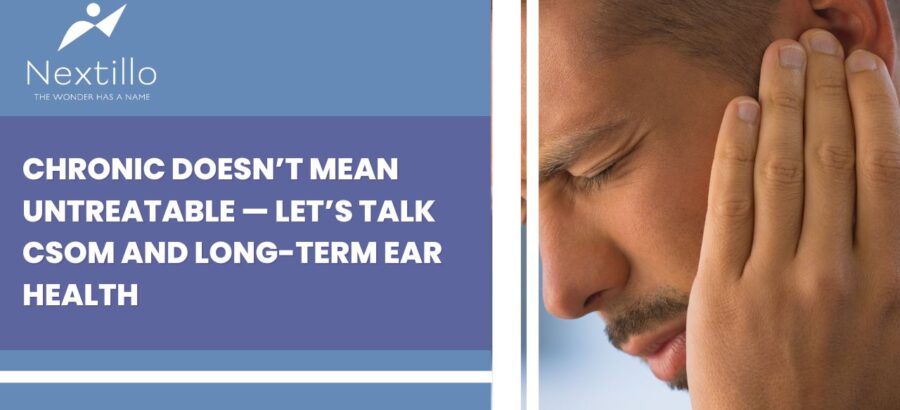CSOM continues to be a significant public health issue in the majority of low- and middle- income countries due to limited access to medical care, unhygienic environments, and overcrowding. CSOM is one of the reasons for preventable hearing impairment, particularly among children and a strong determinant of education, communication, and quality of life.
Chronic Suppurative Otitis Media (CSOM) is a persistent infection of the ear that infects millions of individuals all over the world, particularly in the children of the developing world. Due to prolonged infection and inflammation of the middle ear, CSOM can cause recurrent discharge from the ear (otorrhea), deafness, and life-threatening complications if left untreated.
In this article, we’ll talk about CSOM in detail—what it is, how it develops, its symptoms, diagnosis, treatment, and prevention.
CHRONIC SUPPURATIVE OTITIS MEDIA: WHAT IS IT?
With repeated perforated eardrum ear discharge, chronic suppurative otitis media is a recurring infection of the middle ear and mastoid cavity that typically continues for more than six to twelve weeks. CSOM is a chronic infection that, in contrast to acute and brief otitis media, can recur and cause complications if left untreated.
Let’s talk about CSOM’s causes and risk factors.
RISK FACTORS AND CAUSES
Although recurrent or untreated acute otitis media is typically the cause of CSOM, there are a number of additional factors that can contribute to its development. They are:
- Recurrent upper respiratory tract infections
- inadequate medical treatment of ear infections
- ineffective Eustachian tube function with negative middle ear pressure
- poor hygiene
- Cleft palate or craniofacial disorders
- Exposure to smoke or allergens
Common pathogenic organisms include:
• Pseudomonas aeruginosa
• Staphylococcus aureus
• Proteus species
• Escherichia coli
These bacteria thrive in the moist environment of the middle ear, occasionally forming biofilms that make treatment more difficult.
LET’S discuss the types of csom
There are two types of chronic suppurative otitis media:
- Tubo-tympanic CSOM (safe type):
- Affects the anterior-inferior part of the middle ear (pars tensa)
- Characterized by a central perforation
- Less likely to cause complications
2. Attico-antral CSOM (unsafe type):
- Affects the posterior-superior part of the ear (pars flaccida)
- Typically associated with cholesteatoma (abnormal skin growth in the middle ear)
- has a higher risk of complications, including bone erosion and intracranial extension.
Symptoms of CSOM
The hallmark symptoms of CSOM are
- Otorrhea: Chronic ear discharge, usually purulent and foul-smelling
- Hearing loss: Generally conductive and progressive
- Ear pain or fullness
- Tinnitus (ringing in the ear)
- Vertigo (exceedingly rare)
- Fever or headache (indicative of complications)
In children, CSOM may also result in speech and language delay due to hearing loss.
Diagnosis
Diagnosis of CSOM is primarily clinical, based on history and physical examination. Basic equipment required for diagnosis includes:
- Otoscopy:Shows tympanic membrane perforation, discharge, or cholesteatoma
• Pure tone audiometry: To assess the degree of hearing loss
• Tympanometry: Checks middle ear functioning
• Swab culture and sensitivity tests: To find out the etiological organisms
• Imaging (CT scan): In case of suspicion of complications or cholesteatoma
LET’S discuss the complications of CSOM
Untreated CSOM may lead to serious complications, some of them life-threatening. Complications are classified into two main types.
Extracranial Complications:
• Mastoiditis (infection of the mastoid bone)
• Facial nerve paralysis
• Labyrinthitis (inner ear infection)
• Subperiosteal abscess
Intracranial Complications:
• Meningitis
• Brain abscess
• Lateral sinus thrombosis
• Otitic hydrocephalus
Medical Administration:
Treatment of CSOM involves elimination of infection, drying the ear, and closure of the perforation for restoration of hearing and prevention of recurrence.
- Aural toileting (ear cleaning): To get rid of discharge, use suction or dry mopping.
- Topical antibiotics, such as drops of ciprofloxacin or ofloxacin
- Systemic antibiotics: In cases of acute complications or exacerbations
- Antifungal drops: In the event that a fungal infection is suspected
Steer clear of using ototoxic ear drops (like aminoglycosides) without a doctor’s supervision, particularly if the tympanic membrane is perforated.
Surgical Management:
When medical management is ineffective or complications develop, surgery is usually necessary. Typical practices include the following:
- Myringoplasty: Tympanic membrane repair of the eardrum
- Tympanoplasty: Repairing the eardrum and middle ear
- Mastoidectomy: When a cholesteatoma occurs, the infected mastoid bone is removed.
If surgery is treated early, hearing results are typically favorable.
Prevention of CSOM
Prevention of CSOM includes early detection and treatment of ear infections, as well as overall health and hygiene:
• Early treatment of acute otitis media.
• Ear hygiene—avoid putting objects into the ear.
• Avoid water exposure to ears if there is a known perforation.
• Enhance nutrition and overall immunity.
• Limit exposure to tobacco smoke and allergens.
• Pneumococcal and influenza immunization can minimize the occurrence of otitis media






